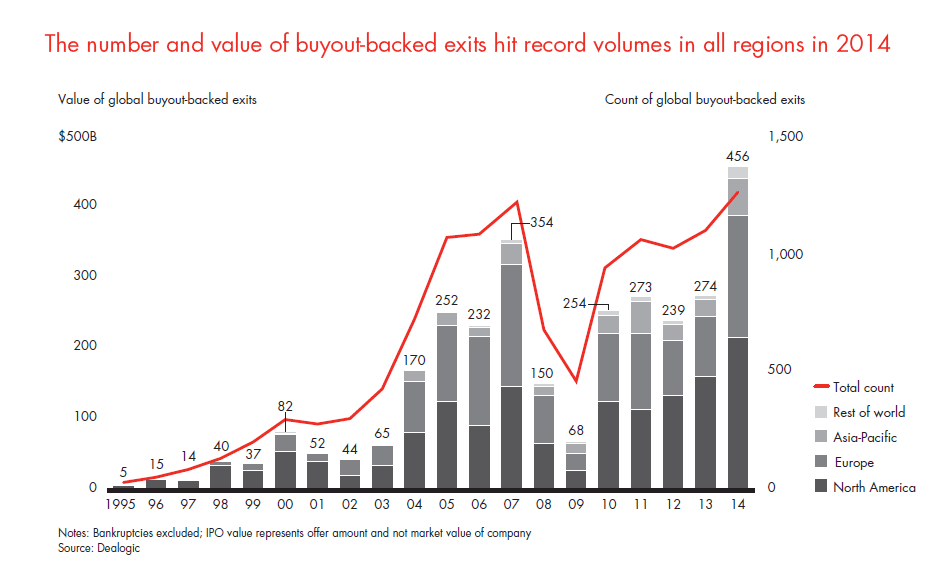Forbes.com
This article originally appeared on Forbes.com.
Optimism was high on the private equity (PE) exit front going into 2014, but as we explain in Bain & Company’s Global Private Equity Report 2015, exits shattered even the lofty expectations of an industry primed for a good year. Worldwide, the number and value of buyout-backed exits reached new records (see figure). At better than 1,250 sales, last year’s exit count surpassed its previous peak of 1,219 transactions in 2007. And total exit value, at $456 billion, also blew past its previous record of $354 billion in 2007 and was 67% higher than it was in 2013.

A global superabundance of capital and sustained high asset valuations powered these dramatic gains in most regions of the world, making sellers rejoice and buyers cautious. There were healthy double-digit increases in the number of buyout exits from the year before: 22% in North America and 16% in Europe. In the Asia-Pacific region, PE exits, including sales of minority stakes in private companies and shares of publicly traded enterprises, jumped 22%, to 476 sales—well above the previous year.
As PE funds continued to harvest the unrealized value in their portfolios, the average holding period has lengthened—and will continue to stretch because so many holdings acquired during the boom years have yet to be fully exited. For buyouts exited in 2014, the median holding period had extended to a record-long 5.7 years, up from just 3.4 in 2008. Many investments made before the global financial crisis simply required more time to be made ready for exit. Indeed, 60% of assets sold in 2014 had been in PE portfolios for more than five years; in comparison, only 11% had been held less than three years.
Exits through all channels increased significantly last year. Sales to strategic buyers have traditionally been the biggest channel for buyout-backed exits, and corporations saw their purchasing power turbocharged in 2014. With capital spending restrained in a hesitant global expansion, corporations sat on unprecedented cash reserves, and the steep climb in public equity markets made their shares a valuable supplemental currency they could use for acquisitions. Historically low interest rates and wide-open debt markets added further rocket fuel to boost corporations’ ability to buy. Corporate acquirers were discerning shoppers for assets that fit their strategic goals, buying 715 PE portfolio companies in 2014—13% more than the year before. And deal sizes were also much larger than in 2013: By value, total exits to strategic acquirers topped $303 billion—a 91% jump.
Robust equity markets were a potent exit channel through initial public offerings (IPOs). Globally, buyout-backed IPOs numbered 210, an increase of 20% over 2013, and their value jumped 48%, to $86 billion. Nearly three-quarters of public offerings floated by PE firms sold within or above their target range. Indeed, because valuations in the public markets were often higher than those of privately held assets, PE firms in many instances pursued dual-track sales processes to maximize the value of their holdings. Exits via IPOs were particularly strong in Europe, where buyout-backed IPOs doubled in number and value in 2014, and in the Asia-Pacific region, where the value of IPOs increased fivefold to $63 billion and exceeded the value of strategic sales and sponsor-to-sponsor exits combined. Accounting for the big increase in the Asia-Pacific region was the reopening of China’s IPO market, a critical venue for IPOs across the region, which regulators had shut amid accounting scandals in late 2012.
As strong as they were, the big official numbers posted in 2014 do not fully reflect how important the healthy IPO market has been to PE firms, because they measure only the value based on the issuing price for the shares offered. What they fail to capture is the imputed full market value of the portfolio company. Examining the 100 biggest PE exits worldwide, a Bain & Company analysis found that 49 were IPOs carrying a market value of $184 billion, which nearly matched the $188 billion disclosed value of the 38 largest strategic sales and the 13 biggest sponsor-to-sponsor deals combined.
The new IPOs also understate in other ways the importance of public equity markets as an exit venue for private equity. PE funds, for example, tapped the strong stock markets in 2014 to issue $103 billion worth of follow-on shares for portfolio companies that had previously held an IPO. In all, the combined value of new buyout-backed IPOs and follow-on issuances from “old exits” totaled $189 billion last year and was a critical source of capital that PE firms could distribute to their limited partners (LPs).
Any year that boasts solid double-digit gains both in the number and value of exited deals has got to be counted as a strong one. By that standard, sponsor-to-sponsor transactions certainly qualified in 2014. By count, sales to PE buyers were up 15%, and by value, they increased a solid 18% over the previous year. Only in a great year for exits would numbers like these look modest, but such were the conditions PE sellers faced in sales opportunities to corporate acquirers and in the hot IPO markets that sponsor-to-sponsor deals trafficked, mainly in leftover holdings.
Written by Hugh MacArthur, Graham Elton, Bill Halloran and Suvir Varma, leaders of Bain & Company’s Private Equity Group.
